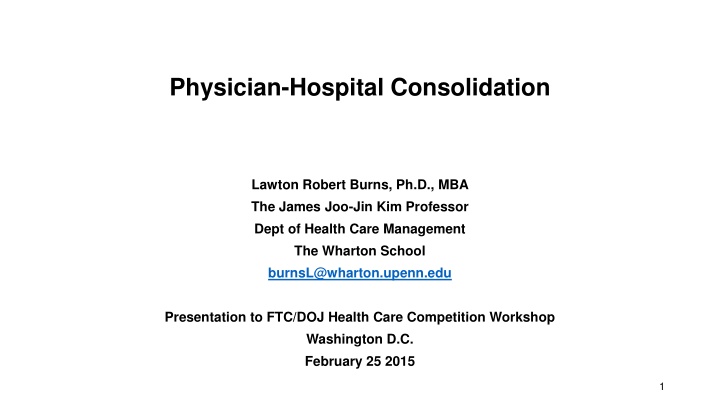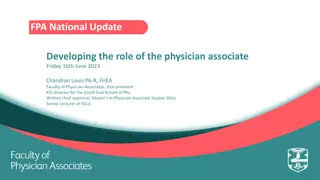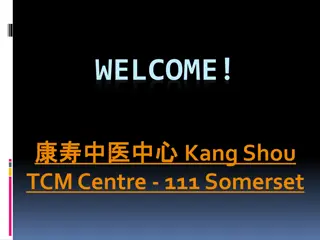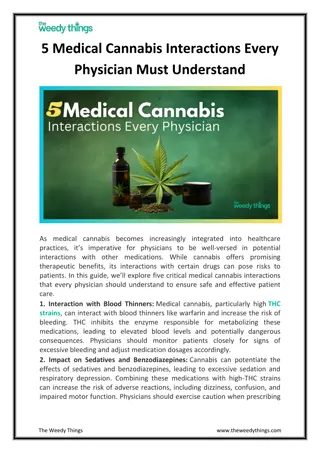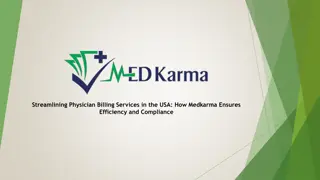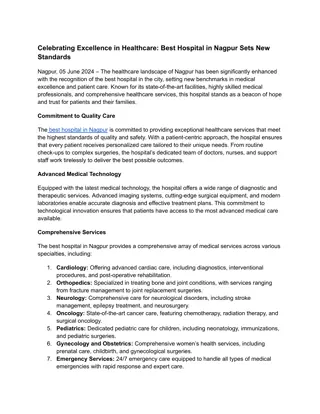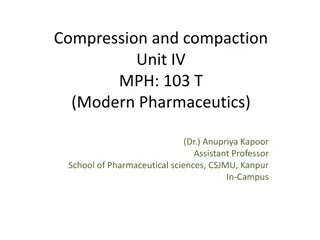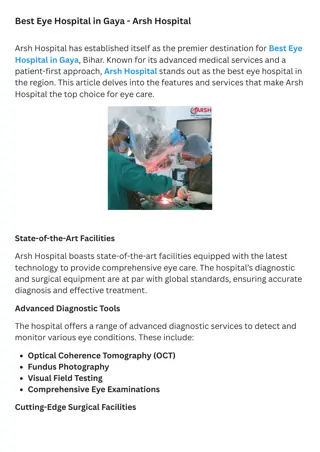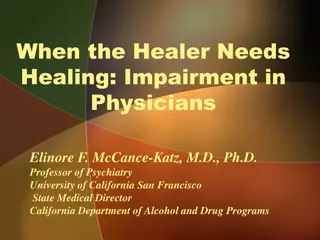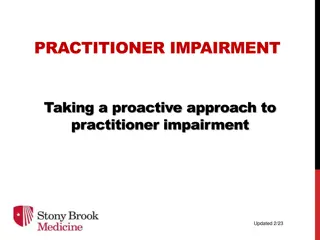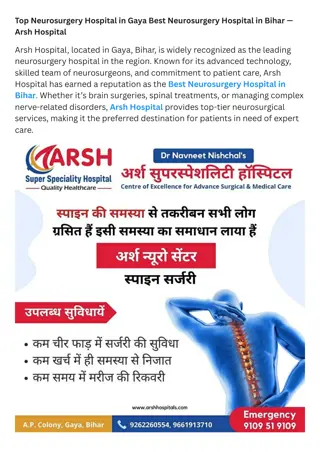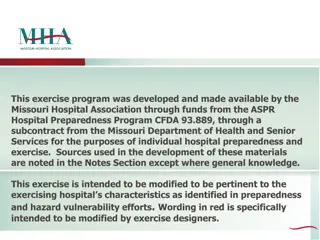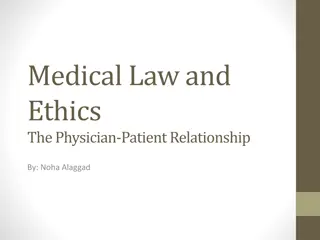Physician-Hospital Consolidation: Types and Impacts
This presentation by Robert Burns explores different types of consolidation in the healthcare industry, including non-economic and economic integration, as well as their impact on quality, cost, price, and profitability. It covers various forms of collaboration and the drivers behind consolidation efforts.
Download Presentation

Please find below an Image/Link to download the presentation.
The content on the website is provided AS IS for your information and personal use only. It may not be sold, licensed, or shared on other websites without obtaining consent from the author.If you encounter any issues during the download, it is possible that the publisher has removed the file from their server.
You are allowed to download the files provided on this website for personal or commercial use, subject to the condition that they are used lawfully. All files are the property of their respective owners.
The content on the website is provided AS IS for your information and personal use only. It may not be sold, licensed, or shared on other websites without obtaining consent from the author.
E N D
Presentation Transcript
Physician-Hospital Consolidation Lawton Robert Burns, Ph.D., MBA The James Joo-Jin Kim Professor Dept of Health Care Management The Wharton School burnsL@wharton.upenn.edu Presentation to FTC/DOJ Health Care Competition Workshop Washington D.C. February 25 2015 1
Vertical Integration Physician and Hospital Linkages Physician Offices Ambulatory Care Outpatient Care Input Markets Hospitals Skilled Nursing Facility Post-Acute Care Output Markets 2
Topics to cover Types of consolidation Extent of consolidation Drivers of consolidation Impact on quality, cost, price, profitability, alignment Alternative forms of collaboration 3
Types of consolidation Take 1 Three types of integration often identified non-economic integration economic integration clinical integration Source: (Burns & Muller, 2008) 4
Non-Economic Integration Technology acquisition Facility upgrade & replacement Hospital branding Marketing of physician practices Physician-to-physician referral programs Increased number and skill-mix of nursing staff Convenience of scheduling tests and procedures Medical staff development plans Medical office buildings Clinical councils Physician liaisons and mediators Physician sales and outreach programs Physician surveys and focus groups Physician retreats Physician leadership development Hospital committees New technology and value analysis committees
Economic Integration Participating Bond Transactions Equity Joint Ventures Outsourcing and Sale of Service Physician Recruitment Part-time Compensation Service Lines Shared Risks Shared Gains Leases Employment uLocation Assistance and Relocation Expense uMedical Directorships uPHO/IPA Risk Contracts with Payers uSupply Chain Management Programs uEquipment Leases uSubordinated Debt Issued to Physicians uCenters of Excellence uAmbulatory Surgery Centers uPractice Acquisition uSyndicate Hospital Ownership and Management to Physicians uDepartment and Program Chairs uTime-share Leases uClinical Institutes uDiagnostic Imaging Centers uSalaried Employment uBonus/ withhold Contracts with Employers uDRG Specific Bundled Payments uPatient Unit Model uStart Up Support: e.g. Salary Guarantee uManagement Contracts uBlock Leases uHospital-in-a- Hospital uFoundation Model uHospital Provision of In-kind Services for Cost Savings uHospitalists uPay-for- Performance Contracts uOn-call Contracts uProcedure Labs uSupport for Group Practice Growth: Incubator Model, Temporary Employment uInter-entity Transfers and Funds Flow Model uMedical Executive Positions (CMO, VPMA) uMedical Office Buildings uPayer Guarantees uSpecialty Hospitals uProfessional Service Agreements uPhysician Hospital Organization (PHO) uLiability Coverage Assistance uRetail Clinics uManagement Services Organizations (MSO) uProduct Line Centers uExclusive Coverage Contracts uIndependent Practitioner Association (IPA)
Clinical Integration Guidelines, pathways, protocols a) development b) implementation Physician & episode profiling Physician performance feedback Physician credentialing Common patient identifier Disease registry Case management Medical management committee Disease management Demand management Clinical information systems Patient self-management skills and education Clinically integrated networks (CINs) Quality improvement steering councils Continuous quality improvement a) inpatient b) outpatient Clinical service lines a) inpatient b) outpatient
Types of consolidation Take 2 Three types of relationship often identified market alliance hierarchy ~ buy hospital medical staff ~ ally PHOs, MSOs, IPAs ~ make hospital employment 8
Extent of consolidation Alliance models (PHO, MSO, IPA) dismal failures in 1990s garnered few capitated lives from insurers no impact on cost or quality no impact on physician alignment no infrastructure to manage risk on the wane ever since may make a comeback with PPACA can serve as the chassis for an ACO 9
Extent of consolidation Hierarchy models (employment) more hospitals now employ physicians not entirely sure how many physicians are employed by hospitals lots of WAGs lots of group think get out your BS detector 10
Extent of consolidation: Estimates Percent of Physicians Employed by Hospitals: Credit Suisse (2013) WSJ (2014) SK&A (2012) AHA (2013) 2/3 of physicians 2/3 of physicians 1/4 of physicians 1/7 of physicians Percent of Medical Groups Employed by Hospitals: SK&A (2012) MGMA (2012) 14-18% of groups 12-13% of groups Percentages vary a lot by specialty 11
Drivers of consolidation Hospital Goals Increase MD incomes Improve care processes & quality Share cost of clinical IT with physicians Prepare for ACOs and Triple Aim Increase leverage over payers Increase physician loyalty/alignment Minimize volume splitting Increase hospital revenues Capture outpatient market Mitigate competition with physicians Develop regional service lines Create entry barriers for key clinical services Recruit physicians in specialties with shortages Address medical staff pathologies Physician Goals Increase MD incomes Increase quality of service to patients Increase access to capital & technology Uncertainty over health reform Low leverage over payers Escape administrative hassles of private practice Escape pressures of managed care Exit strategy for group s founding physicians Increase predictability of case load & income Increase physician control Increase career satisfaction & lifestyle 12
Evidence Base on Physician-Hospital Economic Integration
Literature on Hospital-Physician Integration : Little Evidence for Efficiencies & Benefits Evidence Costs No impact (early research), Positive impact (recent research) Quality Mixed impact Prices Mixed impact (early research), Positive impact (recent research) Hospital profitability Negative impact IT linkages Little impact Clinical integration Little impact Physician alignment Little impact Bundled Payment Seems to lower costs, improve quality Overall, few consistent effects of integration Impact seems to depend on specific form of integration Most integration fails to align physician and hospital incentives Most integration focused on financial, not clinical factors
Alternative Models of Collaboration Non-hospital firms that can integrate with and employ physicians physicians themselves (group practice) insurance companies other equity-backed firms (PPM redux) Other types of vertical integration: hospitals & ASCs hospitals & LTC hospitals & retail clinics pharmacies & retail clinics PBMs & pharmacies 15
